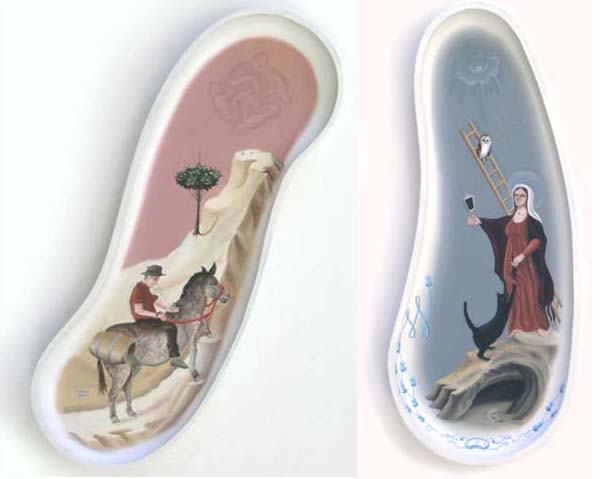Good & Bad Luck: symbols in Matthew Couper's work. An essay by Aaron Lister

Matthew Couper is fascinated by the origins and meanings of symbols. His art bristles with swastikas, crucifixions and secret codes. Often these symbols are irreverently or wittily reinterpreted, forcing us to rethink their meanings. Here Couper paints various symbols of good and bad luck onto two wooden platters.
On the bad luck platter a woman holds a broken mirror while walking under a ladder and meeting a black cat. An all-seeing evil eye and a shrieking owl are other bad omens. On the good luck platter a donkey carrying a barrel of hops is led by a red rope. These are all symbols of good luck, along with the four-leaf clover and horseshoe sitting in the landscape. The rider may have brought his own luck by spitting on a coin, which some believe brings good fortune.
Is the message of this painting that you make your own luck? The use of two painted bowls to represent opposing types of luck suggests that one does not exist without the other. If you believe in good luck, you must accept bad luck. What can lead you to the top of the hill like the man on the donkey can also send you to the desolate cave pictured at the bottom of Bad Luck. The luck-based game Snakes And Ladders works on the same principle. When these two kidney-shaped bowls are hung together they loosely resemble a yin-yang sign, another symbol of these opposing forces that work in harmony.
Art has long been used in the quest to avoid bad luck. Many cultures have traditions of painting charms or symbols on humble, everyday objects to bring good fortune or protection. While Couper follows this lead, he is also working with more circumspect contemporary art practices and issues. These bowls are found objects, purchased from a second-hand store and then painted. The use of found or ready-made objects is a characteristic strategy of contemporary art. Found objects are often used to re-align art with everyday experiences, to insist that art holds no extraordinary powers. This attitude is a world away from the belief that certain symbols and art forms can bring good fortune or protection.
Couper often charges his work by rubbing the contemporary against older art forms, practices and beliefs. He regularly returns to earlier symbols or styles, perhaps as a way of testing contemporary expectations and beliefs in art. The delicate and decorative style of this painting quotes directly from the Byzantine or early Renaissance periods, when art was granted a powerful role in society through its connection with the church and the state.
As part of this return to earlier art forms Couper has painted scores of ex votos, small devotional offerings to particular gods or forces. One of these ex votos offers thanks to the patron god of ‘artistic promotion and development’ for ‘guiding’ the purchase of Good Luck and Bad Luck and its inclusion in this book. Do you believe that powerful forces could have brought these painted bowls in front of you?
Aaron Lister
